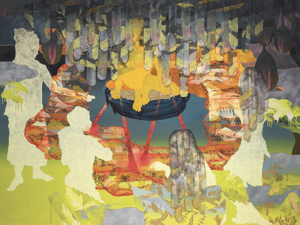
Lien Truong at the Nasher Museum, through July 7th, 2024
Tangentially Related, Often Intertwined
On the surface, love and anarchy may seem like unrelated or even conflicting notions. Love is synonymous with care, compassion, and affection, while anarchy is generally accepted as an absence of authority, a state of disorder, or an ungovernable condition. These concepts, more than tangentially related, are often intertwined and even sometimes mutually dependent. Indeed, moments of disarray and frustration are intrinsic to love, while love sometimes emerges out of disorder and chaos. Drawn from the Nasher Museum’s extensive historical and contemporary collections, Love & Anarchy demonstrates some of the ways in which these two concepts have inspired artists, visually and conceptually, over millennia.
Love has been a subject in art for eternity. In antiquity, Aphrodite, goddess of beauty and love, and her offspring, Eros, repeatedly appeared in painting, sculpture, and pottery. From an ancient Greek depiction of the goddess to a 12th century sculpture of the Virgin enthroned to Marc Quinn’s 21st century rendering of animal carcasses in Mother and Child, Aphrodite’s image resonates across eons. Contemporary depictions of love reveal recognizable poses, gestures, or touch as in Zanele Muholi’s photograph, Katlego Mashiloane and Nosipho Lavuta, Ext. 2, Lakeside, Johannesburg.
Interconnectedness and Interdependence
Anarchy is often represented through similarly personified motifs. War, for example, repeats in works ranging from a 6th century, BCE Greek amphora to Dapper Bruce’s colorful recent drawings. In resistance to war, power, and oppression, depictions of a chaotic psychological or social state are suggested in Lou Stoumen’s dancers at a rock concert from the late 1960s, Kambui Olujimi’s decimated monument in Late Stage Love Affairs, and many other works. Some artists poignantly interweave the concepts of love and anarchy, as in Sherrill Roland’s With Heart, Letter #021414, illustrating their interconnectedness and interdependence. As a result, Love & Anarchy exhibits the nuanced ways these two seemingly disparate themes intertwine over time throughout our visual culture.
Curated by Chief Curator, Marshall N. Price, PhD
